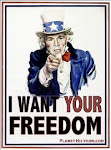MYTHS ABOUT THANKSGIVING
Rick Shenkman, History News Network
THE PILGRIMS HELD THE FIRST THANKSGIVING: To see what the first
Thanksgiving was like you have to go to: Texas. Texans claim the first
Thanksgiving in America actually took place in little San Elizario, a
community near El Paso, in 1598 -- twenty-three years before the
Pilgrims' festival. . . Then again, you may want to go to Virginia.. At
the Berkeley Plantation on the James River they claim the first
Thanksgiving in America was held there on December 4th, 1619. . .
THANKSGIVING WAS ABOUT FAMILY - Thanksgiving was a multicultural
community event. If it had been about family, the Pilgrims never would
have invited the Indians to join them.
THANKSGIVING WAS ABOUT RELIGION - No it wasn't. Paraphrasing the answer
provided above, if Thanksgiving had been about religion, the Pilgrims
never would have invited the Indians to join them. Besides, the Pilgrims
would never have tolerated festivities at a true religious event.
Indeed, what we think of as Thanksgiving was really a harvest festival.
Actual "Thanksgivings" were religious affairs; everybody spent the day
praying. . .
THE PILGRIMS ATE TURKEY - What did the Pilgrims eat at their
Thanksgiving festival? They didn't have corn on the cob, apples, pears,
potatoes or even cranberries. No one knows if they had turkey, although
they were used to eating turkey. The only food we know they had for sure
was deer. So how did we get the idea that you have turkey and cranberry
and such on Thanksgiving? It was because the Victorians prepared
Thanksgiving that way. And they're the ones who made Thanksgiving a
national holiday, beginning in 1863. . .
THE PILGRIMS LANDED ON PLYMOUTH ROCK - According to historian George
Willison, who devoted his life to the subject, the story about the rock
is all malarkey, a public relations stunt pulled off by townsfolk to
attract attention. . . Anyway, the Pilgrims didn't land in Plymouth
first. They first made landfall at Provincetown.
PILGRIMS LIVED IN LOG CABINS - No Pilgrim ever lived in a log cabin. The
log cabin did not appear in America until late in the seventeenth
century, when it was introduced by Germans and Swedes. The very term
"log cabin" cannot be found in print until the 1770s. Log cabins were
virtually unknown in England at the time the Pilgrims arrived in
America. . . The Pilgrims lived in wood clapboard houses made from sawed
lumber.
PILGRIMS DRESSED IN BLACK - Not only did they not dress in black, they
did not wear those funny buckles, weird shoes, or black steeple hats. .
. Plymouth Plantation historian James W. Baker explains that in the
nineteenth century, when the popular image of the Pilgrims was formed,
buckles served as a kind of emblem of quaintness. That's the reason
illustrators gave Santa buckles. Even the blunderbuss, with which
Pilgrims are identified, was a symbol of quaintness. The blunderbuss was
mainly used to control crowds. It wasn't a hunting rifle. But it looks
out of date and fits the Pilgrim stereotype.
PILGRIMS, PURITANS -- SAME THING - Pilgrims and Puritans were two
different groups. The Pilgrims came over on the Mayflower and lived in
Plymouth. The Puritans, arriving a decade later, settled in Boston. The
Pilgrims welcomed heterogeneousness. Some (so-called "strangers") came
to America in search of riches, others (so-called "saints") came for
religious reasons. The Puritans, in contrast, came over to America
strictly in search of religious freedom. Or, to be technically correct,
they came over in order to be able to practice their religion freely.
They did not welcome dissent. That we confuse Pilgrims and Puritans
would have horrified both. . .
http://hnn.us/articles/406.html
||||||||||||||||||||||||||||||||||||||||||||||||||||||||
PILGRIM'S FOLLY
SAM SMITH - I have considered Pilgrims among the most overrated American
historical figures ever since he wrote a college paper in Robert G.
Albion's class on forty recorded voyages to New England before the
Mayflower. And that didn't include all the ones made by those who didn't
- or didn't know how - to write it down. About a decade before the
Pilgrims, for example, Samuel Champlain not only visited Plymouth
harbor, he charted it, including Plymouth Rock.
But history favors occupiers over explorers, hunters, fishermen, and
traders. And the literate over the literate. If you want to be
remembered here, you have to stay here. And write it down.
A wonderful history of Maine, "Lobster Coast," also suggests that the
Pilgrim's Thanksgiving dinner didn't hold up all that well. That winter
the Pilgrims were forced to go to get food from some of their
pre-arriving countrymen manning a trading post on a Maine island.
The first Europeans to visit New England waters were probably
Scandinavian fishermen, who could make the northern transit of the
Atlantic and never be more than a few hundred miles from shore. John and
Sebastian Cabot, five years after Columbus, passed through and charted
Maine's Casco Bay on their way from Nova Scotia to the Carolinas. By
1602, when Bartholomew Gosnold arrived at Cape Neddick, his presence was
considered by the Indians to be less than remarkable. John Bereton, the
chronicler of the voyage, wrote:
"One who seemed to be their commander wore a coat of black work, a pair
of breeches, cloth stockings, shoes, hat and band. . . They spoke
divers Christian words and seemed to understand more than we, for lack
of language, could comprehend. . . They pronounced our language with
great facility; for one of them sitting by me, upon occasion I spake
smilingly to him with these words: 'How now sirha are you so saucy with
my tobacco,' which words (without any further repetition) he suddenly
spake so plaine and distinctly as if he had been a long scholar in the
language."
As far back as 1524, Giovanni da Verrazano, arriving to the west of
Casco Bay near Ogunquit, got a reception from the Indians that suggested
more than a little previous contact with Europeans or "the boat people"
as the natives called them. The Indians insisted on standing on a cliff
and trading with Verrazano's crew by use of a rope. "We found no
courtesy in them," Verrazano complained. Worse they rounded out the
transaction by "showing their buttocks and laughing immoderately."
As for Robert G. Albion, who got your editor started on all of this, his
course was considered a "gut" at Harvard, heavily attended by
football players and other lightweights. While I fit the latter
category, I also was an avid sailor and an admirer of Albion's mentor,
maritime historian Samuel Eliot Morrison. Much later, I realized another
reason Albion didn't get much credit at Harvard; he was, well ahead of
his time, a social historian on a campus that believed deeply that
history was the work of great men. Nonetheless, another student of
Albion named his motor yacht the "Robert G. Albion," making the
professor probably the only Harvard professor ever to reach this
pinnacle of honor.
||||||||||||||||||||||||||||||||||||||||||||||||||||||||
Subscribe to:
Post Comments (Atom)





















No comments:
Post a Comment